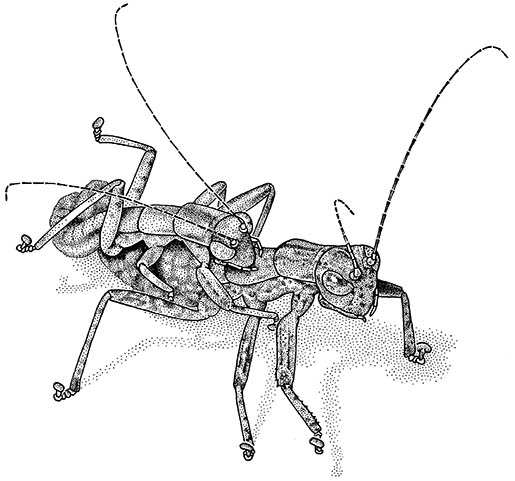Box 13.3. Mantophasmatodea (heel walkers)
The discovery of a previously unrecognized order of insects is an unusual event. In the 20th century only two orders were newly described: Zoraptera in 1913 and Grylloblattodea in 1932. The opening of the 21st century saw a flurry of scientific and popular media interest concerning the unusual discovery and subsequent recognition of a new order, the Mantophasmatodea.
The first formal recognition of this new taxon was from a specimen preserved in 45 million year old Baltic amber, which bore a superficial resemblance to a stick- insect or a mantid, but evidently belonged to neither. Shortly thereafter a museum specimen from Tanzania was discovered, and comparison with more fossil specimens including adults showed that the fossil and recent insects were related. Further museum searches and appeals to curators uncovered specimens from rocky outcrops in Namibia (south-west Africa). An expedition found the living insects in several Namibian localities, and subsequently many specimens were identified in historic and recent collections from succulent karoo and fynbos vegetation of South Africa.
The Mantophasmatodea was named for its superficial resemblance to two other orders. In an assessment of the morphology it was difficult to place the new order, but relationships with the phasmids (Phasma- todea) and/or rock crawlers (Grylloblattodea) were suggested. Nucleotide sequencing data have justified the rank of order, and confirmed that it forms the sister group to Grylloblattodea. Currently there are three families, with two extinct and 10 extant genera, and 13 described extant species (mostly undescribed), now restricted to south-western and South Africa, and Tanzania in eastern Africa.
Mantophasmatids are moderate-sized (1.1–2.5 cm long in extant species, 1.5 cm in fossil species) hemimetabolous insects, with a hypognathous head with generalized mouthparts (mandibles with three small teeth) and long slender antennae with 26–32 segments and a sharply elbowed distal region. The prothoracic pleuron is large and exposed, not covered by pronotal lobes. Each tergum of the thorax narrowly overlaps and is smaller than the previous. All species are apterous, without any rudiments of wings. The coxae are elongate, the fore and mid femora are somewhat broadened and with bristles or spines ventrally. The tarsi are five- segmented with euplanulae on the basal four, the ariolum is very large and, characteristically, the distal tarsomere is held off the substrate (hence the name “heel walkers”). The hind legs are elongate and can be used in making small jumps. Male cerci are prominent (as on the male shown in the Appendix, after a photograph by M.D. Picker), clasping, and do not form a differentiated articulation with the 10th tergite. Female cerci are one-segmented and short. The ovipositor projects beyond the short subgenital lobe and there is no protective operculum (plate below ovipositor) as occurs in phasmids.
Copulation may be prolonged (up to three days un- interrupted) and, at least in captivity, the male is eaten after mating. The male mounts the female with his genitalia engaged from her right-hand side, as shown here for a copulating pair of South African mantophas-matids (after a photograph by S.I. Morita). A South African species was observed to lay 12 very large eggs in an egg pod made up of a foam mixed with sand and laid superficially in the soil. An ethanol-preserved specimen from Namibia had 40 eggs within its abdomen. The life cycle is not well known, although studies are in progress and it is known that the molted cuticle is eaten after ecdysis. At least one Namibian species seems to be diurnal, whereas South African species are nocturnal. Mantophasmatids are either ground dwelling or live on shrubs or in grass clumps. They are predatory, feeding for example on small flies, bugs, and moths. For this reason, the common name “gladiators” has been proposed for the order, although we prefer the more descriptive “heel walkers”. Raptorial femora are grooved to receive the tibia during prey capture; at rest the raptorial limbs are not folded. Most species exhibit considerable color variation from light green to dark brown. Males generally are smaller and of a different color to females.
Based on molecular evidence, their sister group is the Grylloblattodea, one of the suggested relationships based on morphology (section 7.5 and Fig. 7.2). Winged insects otherwise resembling Mantophasmatodea are known from the Upper Carboniferous (300 mya). These belong to the extinct order Cnemidolestodea, and may reflect an ancient radiation of which Mantophasmatodea and perhaps Grylloblattodea are wingless relicts.


Broken lines indicate uncertain relationships. Thysanura sensu lato refers to Thysanura in the broad sense. (Data from several sources)



